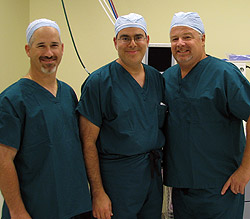Manipulation Under Anesthesia | Manipulation Overview | MUA History
MUA Pathomechanics | MUA Success Stories | Pain Management
MUA FAQ’s | MUA Research
Manipulation Under Anesthesia in Princeton
Manipulation Under Anesthesia, or MUA, is a highly specialized, non-invasive chiropractic technique used for chronic pain patients who are no longer responding to regular (conventional) conservative care. MUA works by altering adhesions and fibrotic scar tissues to restore range of motion and mobility while the patient is in a safe, temporary “twilight sleep.” As an alternative therapy to surgery and medication, MUA consistently generates life-changing results for carefully selected patients.

Our team of chiropractors are specially trained in MUA.
Manipulation Under Anesthesia (MUA) is a treatment option for people suffering with muscular and spinal pain. This treatment is gaining popularity and may offer you the opportunity to greatly reduce if not eliminate your pain. This treatment uses twilight sedation to relax the muscles. Once relaxed, the patient is gently stretched and fixations in the spine are released. This allows greater movement and flexibility which is free from pain. Many patients awake feeling better than ever.
Dr. Edward V. Sofo, the director of Pro Rehab and Princeton Chiropractic and Sports Rehab, performs MUA for patients wanting a life free from pain and dependence on medications. Dr. Sofo has successfully preformed the procedure on many patients. He was certified to perform the MUA procedure through the MUA Research Institute. Because of his expertise in the techniques Dr. Sofo often assists Dr. Jason Tirado, the founder of the MUA Research Institute, when he trains new doctors in the specialized techniques of Manipulation Under Anesthesia.
Manipulation Under Anesthesia (MUA) is a procedure that is intended for patients that suffer from sometimes acute, but mostly chronic musculoskeletal disorders in conjunction with biomechanical aberrancies. These individuals have also been unresponsive to previous conservative therapy. Etiology of their pain can be disc bulge/herniation, chronic sprain/strain, failed back surgery, myofascial pain syndromes in conjunction with those listed below. The procedure is extremely beneficial for the patient that has muscle spasm accompanied with pain and terminal joint range of motion loss. These types of patients typically respond well to manipulation/physical therapy/exercise, but their relief may only be temporary (days to weeks). To ensure good results with a procedure of this type, one of the most important considerations is patient selection.
Indications for MUA:
- Chronic Headaches
- Chronic Myositis; muscle pain & inflammation
- Nerve entrapment
- Chronic fibrositis
- Conditions responding poorly to other conservative treatments
- Acute & chronic muscle spasm
- Frozen shoulder
- Hip joint pain
- Sciatica or sciatica like symptoms
- RSD
- Conditions that do not respond to medications
- Failed back surgery
- Chronic disc changes
- Failed physical therapy
- Bulging, protruded, prolapsed or herniated discs without free fragment and are not surgical candidates.
- Frozen or fixated articulations from adhesion formation.
- Compression syndromes with or without radiculopathies caused from adhesion formation, but not associated with osteophytic entrapment.
- Restricted motion which causes pain and apprehension from the patient, but manipulation is the therapy of choice.
- Unresponsive to manipulation and adjustment when they are the treatment of choice.
- Unresponsive pain which interferes with the function of daily living and sleep patterns, but which fall within the parameters for manipulative treatment.
- Unresponsive muscle contracture which is preventing normal daily activities and function.
- Post traumatic syndrome injuries from acceleration/deceleration or acceleration/deceleration types of injuries which result in painful exacerbations of chronic fixations.
- Chronic recurrent neuromusculoskeletal dysfunction syndromes which result in a regular periodic treatment series that are always exacerbations of the same condition.
- Neuromusculoskeletal conditions which are not surgical candidates, but have reached MMI (maximum medical improvement), especially with occupational injuries.
Chiropractic patients whose symptoms have improved but also have reached a plateau using traditional therapy also can significantly improve their quality of life using MUA.
What Happens During an MUA Procedure?

Once relaxed, the patient is gently stretched and fixations in the spine are released
An MUA is a non-invasive procedure performed in a surgery center or hospital. It is almost exactly like spinal manipulation in an office except is uses the anesthesia as an aid. A small amount of intravenous anesthesia is administered by a board certified anesthesiologist. The procedure usually lasts less than 25 minutes. The areas of dysfunction are stretched and manipulated to function normally. The patient wakes up and is monitored until they are on their way home, usually within the hour.
What Can I Expect After MUA?
The MUA is typically done over a series of 3 visits. This prevents the adhesions or spasms from returning (adhesions reform is 24-36 hours). After the procedure is done you will be asked to return to our office (or the referring physician’s office) for approximately 6 – 8weeks of Post-MUA therapy. This will consist of therapeutic stretches, spinal manipulation, vibration therapy, and range-of-motion strengthening exercises. The patient may experience some soreness (like leaving a workout after the first time), that is normal.
To see how dramatic the effects of MUA can be check out the television health reports below or read some of our patient testimonials. MUA is an age-old, yet revolutionary procedure that can give you your life back.
Is MUA covered by my insurance?
MUA is not an experimental procedure and it is covered by most insurance carriers. For more information or to make an appointment for a consultation please contact our Princeton office.
Call our Princeton chiropractic office today!
and Sports Rehab
601 Ewing St., Ste C3,
Princeton, NJ 08540
(609) 921-1705


